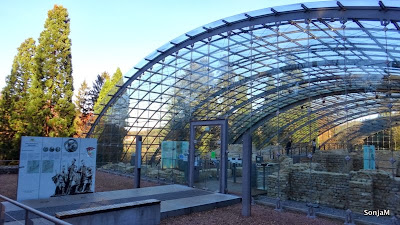We gladly payed the 2 € entry fee. An award winning glass roof is covering the complex. The modern architecture creates a stark but pleasant contrast to the ruins. It is a piece of art in itself, and bonus: it effectively protects the remains from further decay.
The construction of the bath houses began in the first century AD, and more buildings were successively added due to the growing interest of the population. The floor plan is symmetrical in shape, likely with one section for women, and the one on the opposite side for men. Those almost two thousand years old remains are in amazingly good shape.
During excavation amazing Roman plumbing had been found as well. Of course they had a system for running hot and cold water, and a different channel system for grey water, too.
A cold water pool and a maintenance shaft.
This is how it might have looked like:
Far left and right: A leisure garden,
from there one would enter the changing facilities.
Sweat rooms could be found in the back of the building.
Adjacent round pools would provide cold water after the sauna session.
The four squares in the middle would have been the thermal pools,
and of course there would have been a heated floor system.
After the fall of the Roman Empire this wonderful culture of bath houses seemed to wane. With the arrival of the Middle Ages everything known about personal hygiene and wellness seemed forgotten. Maybe that's why they call it "The Dark Ages"? The Roman spa had been torn down and its building material used to build a fortress. As a matter of fact it was long believed that nearby Castle Baden was from Roman origin. However, it was founded in the 12th century, and indeed built with bricks from the former bath house.
The castle was meant to protect the nearby silver mines, and strategically built on a steep hill, and not easy to conquer (even today… we were well out of breath after we climbed it.).In the 17th century the castle was besieged, destroyed, and never rebuilt or reused again, and left to fall into ruins.
And so nature reclaimed what was once a mighty castle.
The small town of Badenweiler still has more architectural gems to offer, such as the house of culture, formerly a residence of the margrave of Baden, built at the end of the 16th century.We left this town with the desire to come visit again to learn more about this history laden location. With no further ado we hit the roads only to be confirmed that we got to be back. The surrounding scenery was simply gorgeous. Alas, the light was fading and we had to rush back to Offenburg, as we would meet friends on the Christmas Market (This market was for once nothing to write home about.).


















I enjoy the tourist mode text and photos. A wonderfully historic part of the world. Thank you for sharing!
ReplyDeleteWe're all very lucky that you can so easily transition to Tourist Mode from Errand/Shopping mode. A lesson to us all. Thanks for taking us along!
ReplyDeleteIt's simple curiosity that takes over. Errands have to wait ;-)
DeleteI wonder if there was a large debate over the creation of the glass roof. It's a contrast, for sure, but seems the best way to preserve and experience the ruins.
ReplyDeleteWhat is your altitude?
There was indeed, Martha. It took from the mid 80's to the new millennium from planning to construction.
DeleteWow, I can't believe how green it still is ... looks like late summer.
ReplyDeleteNot quite, it had around zero degrees. The leaves are almost gone but the grass still looks good.
DeleteSo neat to stumble upon such a treasure. Always interesting to see a little more of the history of the area.
ReplyDeleteIt looks like a beautiful place to wander and spend a few hours. Thanks for sharing.
I love it when a day takes a turn like this. It was a lovely historical gem that we came across.
DeleteNice to see you've your priorities straight, errands will always be there....thanks for the pics.
ReplyDeleteWe worked hard on this priority thing ;-) Being German living in Canada and the people's mindset helped a lot with that.
DeleteWith regard to mindset: as we say in Canada," You will be assimilated....resistance is futile".
ReplyDeleteDavid, that's why we are Canadian, and we gladly volunteered to be assimilated.
DeleteThanks for your report. It is very interesting. I love old houses, castles and museums to see / to visit. you two enjoying life.
ReplyDeleteMerry Christmas for both of you.
Mecki
Thanks Mecki, in terms of enjoying life we do as best as we can ;-)
DeleteSonja, Roland, it's a very busy time of year and I have been largely absent. Thanks for sharing those Roman ruins. What the dark ages took away is peace and tranquility. Roman baths could only exist in a peaceful society. They are a symptom of the remarkable pax romana. Of course the pax romana was itself an outgrowth of Roman brutality in subjugating native peoples. And now the pendulum is back into peace mode in the EU. The pax americana having succeeded to the brutality of the mid-twentieth century. Now all the world's brutality is being visited on sectarian strife in Africa and the Middle East, with occasional forays of terrorism in the west. Let's hope that the peace/strife pendulum remains forever more in peace mode.
ReplyDelete